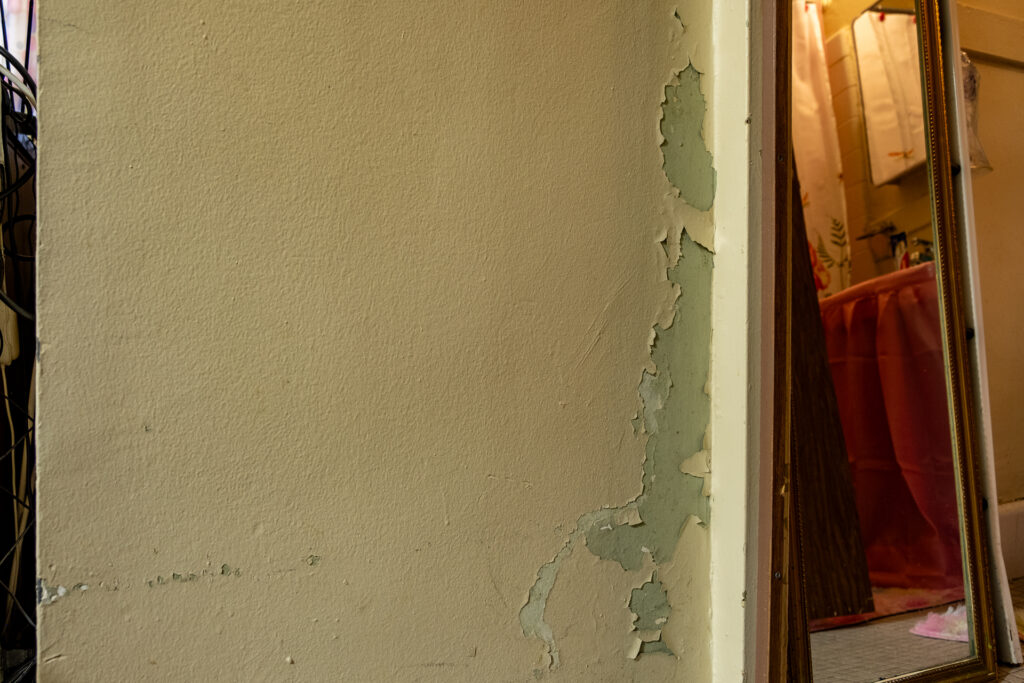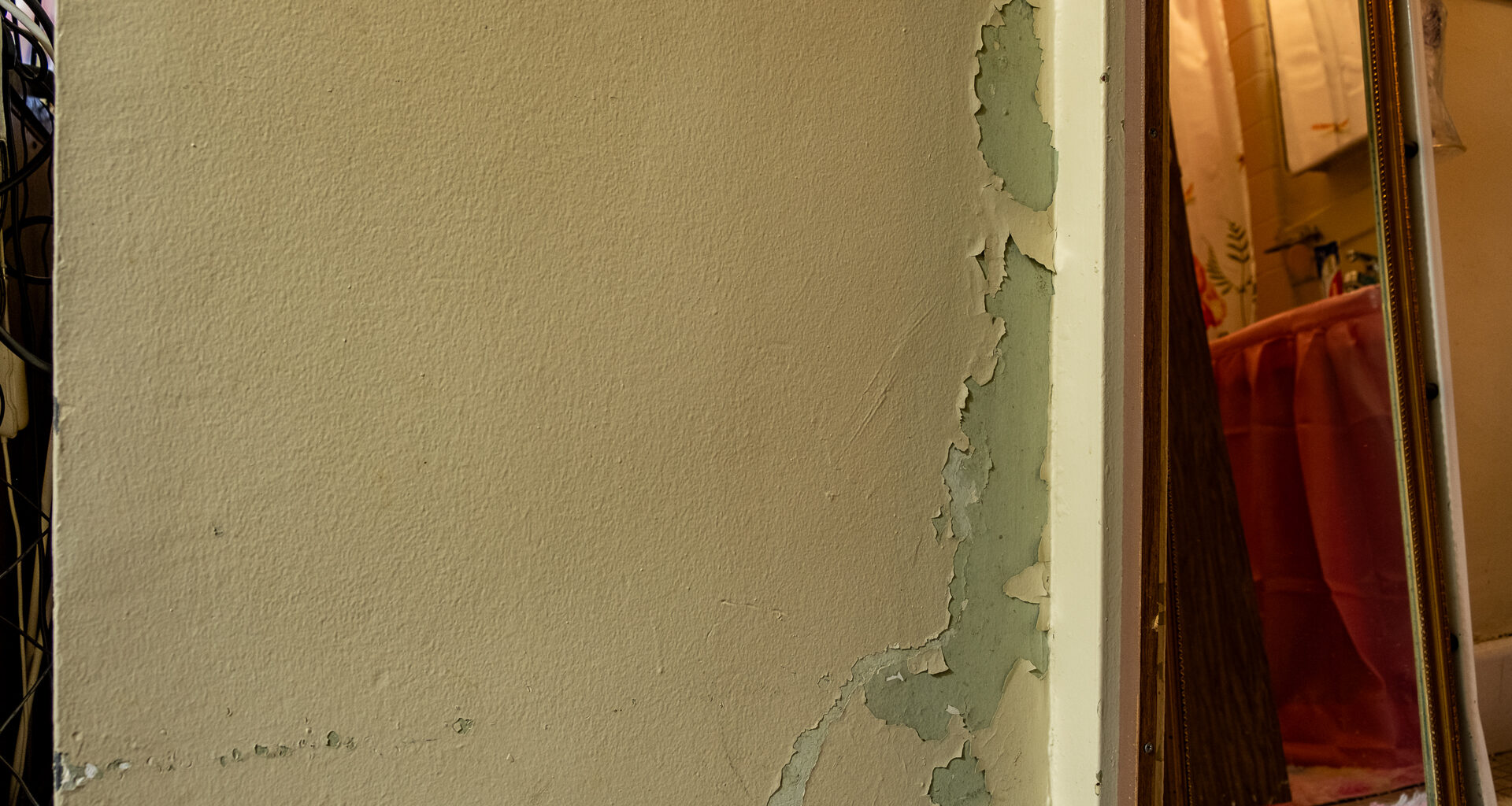“Education around lead, and especially lead paint hazards, is something that still is really necessary,” said housing advocate Brandon Kielbasa. “People think of it as something that’s been dealt with already, [but] there’s still about 5,000 kids a year who are poisoned in New York City.”
 Peeling paint can be a source of lead exposure in homes. (Adi Talwar/City Limits)
Peeling paint can be a source of lead exposure in homes. (Adi Talwar/City Limits)
It’s been more than six decades since New York City banned the use of lead paint in residential buildings—one of the first cities in the nation to do so, recognizing the health risks it posed, particularly for children.
But the age of the city’s housing stock means lead paint is still a presence: last year, 4,655 New York City children under the age of 6 tested positive for elevated lead levels in their blood, according to public data.
As part of Lead Poisoning Prevention Week, which runs Oct. 18-25, city officials and housing advocates are looking to get the word out about the hazards of lead exposure—and what tenants and property owners can do to mitigate their risks.
“Education around lead, and especially lead paint hazards, is something that still is really necessary,” said Brandon Kielbasa, director of policy and organizing at the Cooper Square Committee.
“People think of it as something that’s been dealt with already, [but] there’s still about 5,000 kids a year who are poisoned in New York City,” he said. “And we’re finding out more and more every day about how it’s bad for adult health, and that’s not really being tracked, honestly.”
Cooper Square Committee, along with the Lead Dust Free NYC coalition and BetaNYC, recently launched a new online mapping tool that lets people enter their address to see when their building was constructed—what can be a helpful indicator for the presence of lead paint.
New York City buildings constructed before 1960, when the city passed its ban, are presumed to contain lead paint. But even properties built later than that can pose a risk, since New York State didn’t prohibit its use in homes until 1970, and a nationwide ban didn’t take effect until 1978.
“The kind of rule of thumb that we use as advocates is: the older the building, the more there is typically,” said Kielbasa. While only proper testing can confirm the presence of lead paint, he said the map is intended to serve as a “starting point” for tenants and building owners to investigate further.
Under a city law passed in 2020, landlords of properties constructed before 1960 were required to test apartments and common areas for the presence of lead paint by Aug. 9, 2025. If those tests determine there is no lead paint—or if the owner successfully abates it—they can apply with the city’s Department of Housing, Preservation and Development for an exemption from other lead paint requirements.
That includes providing annual notices to tenants about lead-based paint hazards, as well as conducting yearly inspections of apartments where a child under 6 resides and to correct any issues they identify, such as chipped or peeling paint.
In the most recent fiscal year that ended in June, HPD issued 20,380 violations and collected $90,000 in civil penalties for lead-based paint hazards and record-keeping violations, officials say.
 A lead paint testing tool. (Michael Appleton/Mayoral Photography Office)
A lead paint testing tool. (Michael Appleton/Mayoral Photography Office)
Of particular concern are window and doors frames—known as “friction surfaces” because their use can wear the paint down and expose older layers underneath, creating microscopic dust.
Building construction and renovations is another source of exposure, Kielbasa said, with tenants in low-income communities and communities of color disproportionately impacted.
“It’s almost like this double whammy that can hit gentrifying communities, where they live with dilapidated building conditions and the neighborhood isn’t as attractive,” he said. “And then as soon as it becomes attractive, it attracts the type of investor who wants to get work done as fast and cheap as possible, and they’re the same type of investor and landlord that might cut corners on controlling the dust.”
Throughout this week, the city is hosting a series of public events and informational workshops about lead poisoning; you can find a full schedule here.
Officials also offered the following tips for tenants:
Immediately report peeling or damaged paint to your building’s owner or managing agent. Call 311 to report it if your landlord fails to act.
Frequently wash your floors, windowsills, hands, and children’s toys.
Remove your shoes before entering your house. If someone in your household works in construction, wash their clothes separately.
Avoid using products from other countries that may contain lead. For more information, visit nyc.gov/hazardousproducts.
In addition to paint, the pipes that carry water into homes, known as service lines, can also contain lead. You should let the water run for at least 30 seconds before using it, and use only cold tap water when drinking, cooking, and preparing baby formula. The city offers free drinking water test kits, which you can request by calling 311.
To reach the editor, contact [email protected]. Want to republish this story? Find City Limits’ reprint policy here.
We want to hear from you!
Take a short anonymous survey to help us deliver content to empower our community.

